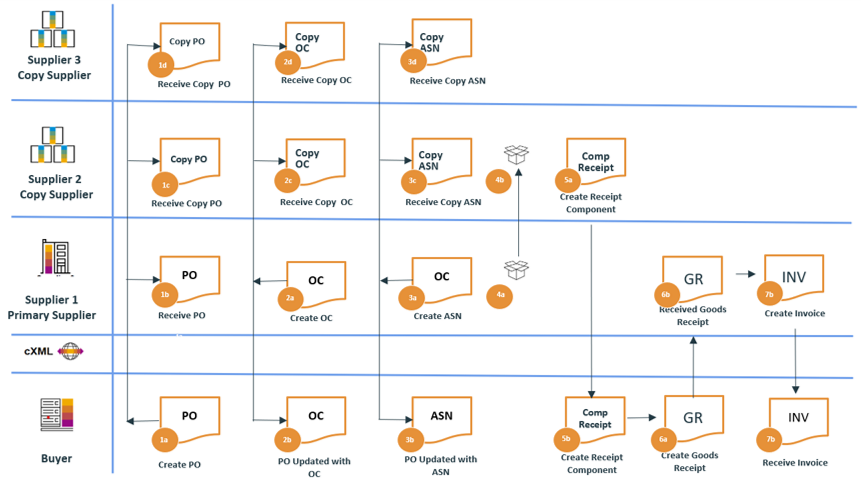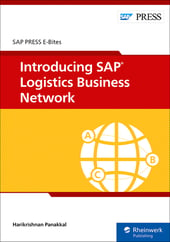Multi-tier collaboration is a business model that allows collaboration with multiple suppliers or business partners in real time.
Multi-tier collaboration can be used as a standalone tool or it can be combined with subcontracting, the business model that allows organizations to outsource a part of the manufacturing process to another entity.
SAP Business Network enables an organization to collaborate with multiple business partners through SAP Multi-Tier Collaboration. This solution provides transparency and real-time updates by copying purchase orders (POs), order confirmations, and advance ship notifications to multiple suppliers.
The business partners in SAP Multi-Tier Collaboration can be categorized into one primary supplier and one or more copy suppliers. The copy suppliers can be component suppliers, or they can be other types of suppliers such as logistics providers. The PO is sent to the primary supplier with copies also sent to the copy suppliers. (The same is true for order confirmation and advanced ship notice documents.) The primary supplier creates these documents and then sends them to the buyer, along with a copy to the copy suppliers. The buyer has the opportunity to hide sensitive information, such as net price, from being copied over to copy suppliers. Only the PO, order confirmation, and advance ship notifications get copied. Goods receipt and invoices do not get copied.
The Multi-Tier Collaboration Process with SAP
The following gives an overview of the multi-tier collaboration process with SAP.
There are several process steps in multi-tier collaboration:
- The buyer sends the PO to the primary supplier. A copy of PO is sent to the copy suppliers. In the example below, the copy suppliers are component suppliers and logistics suppliers.
- The primary supplier sends an order confirmation. A copy of the order confirmation is sent to the copy suppliers.
- The primary supplier sends advance ship notification. A copy of the advance ship notification is also sent to the copy suppliers.
- The primary supplier sends the components to one of the copy suppliers. In the figure below, this would be supplier number two.
- Supplier number two sends a component receipt to the buyer. This triggers a component receipt at the buyer.
- The component receipt at the buyer creates a goods receipt at the buyer. This in turn creates a goods receipt at the primary supplier.
- The primary supplier now creates an invoice based on the goods receipt. The invoice is sent to the buyer.

Subcontracting with SAP Multi-Tier Collaboration
It is possible to combine the features of subcontracting collaboration with multi-tier collaboration. This potent mix has the potential to dramatically transform the manufacturing processes within a business.
The process described here involves the buyer, a subcontractor, and two component suppliers. At a high level, the process works like this:
- The buyer sends a subcontracting PO to the subcontractor.
- The buyer sends a PO for component one to component supplier one. Component one is shipped to the subcontractor.
- The buyer sends a purchase order for component two to component supplier two. Component two is shipped to the subcontractor.
- The subcontractor assembles the components and ships the final product to the buyer.
The process would look like the figure below.

The process steps can be divided into four major parts:
- Collaboration between buyer and subcontractor for purchase order and order confirmation.
- Collaboration among parties for component one
- Collaboration among parties for component two
- Collaboration between buyer and subcontractor for goods receipt and invoice
For a more detailed outline, the process follows this order.
Collaboration Among Business Partners for Component One
- The buyer sends a PO to component supplier one, with copies to the subcontractor and component supplier two.
- Component supplier one sends an order confirmation to the buyer, with copies to the subcontractor and component supplier two.
- Component supplier one sends an advance shipping notification to the buyer, with copies to the subcontractor and component supplier two.
- Component supplier one then ships components to the subcontractor.
- The subcontractor sends a component receipt to the buyer.
- The buyer then sends a goods receipt to component supplier one.
- The component supplier then sends an invoice to the buyer.
Collaboration Among Business Partners for Component Two
- The buyer sends a PO to component supplier two, with copies to the subcontractor and component supplier one.
- Component supplier two sends an order confirmation to the buyer, with copies to the subcontractor and component supplier one.
- Component supplier two sends an advance shipping notification to the buyer, with copies to the subcontractor and component supplier one.
- Component supplier two ships components to the subcontractor.
- The subcontractor sends a component receipt to the buyer.
- The buyer then sends a goods receipt to component supplier two.
- The component supplier then sends an invoice to the buyer.
Collaboration Between Buyer and Subcontractor for Goods Receipt and Invoice
- The subcontractor consumes the components to produce the finished goods.
- The subcontractor sends the component consumption information to the buyer.
- The subcontractor sends an advance shipping notification to the buyer for finished goods.
- The subcontractor ships the finished goods to the buyer.
- The buyer performs a goods receipt. The components are consumed at this point if backflushed.
- The subcontractor then sends an invoice.
What Are the Benefits of SAP Multi-Tier Collaboration?
SAP Business Network-based multi-tier collaboration, along with subcontracting collaboration, provides a number of benefits. Firstly, it delivers instantaneous updates on purchase orders, order confirmations, and advance shipping notifications to the appropriate partners throughout the supply chain. Next, it offers complete insight into pending order quantities and shipments across the entire supply chain. And finally, immediate updates enhance the efficiency of transactions and reduce delays within the supply chain.
Conclusion
The modern supply chain is intricate. It involves numerous business partners spread across various regions to produce a product. In this context, having visibility and immediate updates on components throughout the supply chain is crucial. SAP Business Network Supply Chain Collaboration's multi-tier collaboration function (SAP Multi-Tier Collaboration) is an effective tool that offers this needed visibility and real-time updating. When integrated with subcontracting collaboration, it enables manufacturers to distribute portions of their manufacturing processes to various business partners. This approach not only allows the original manufacturer to delegate parts of its production, but also maintains transparency over the entire supply chain.
This post was originally published 1/2024.




Comments